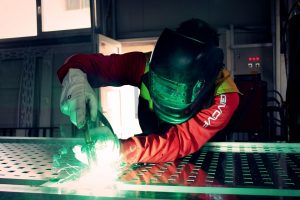
Shielded metal arc welding (SMAW) and tungsten inert gas (TIG) are two of the most common and widely used welding processes today. They both rely on the use of heat to melt and join multiple metal or thermoplastic objects. When the metal objects cool, they harden and fuse together. But SMAW isn’t the same as TIG welding. To learn more about the differences between SWAW and TIG welding, keep reading.
What Is SMAW?
Also known as manual metal arc welding, SMAW is a welding process that’s characterized by the creation of a welding arc between a consumable electrode — typically made of the flux-covered steel — and the base metal or material. During SMAW, the welding torch holds this electrode while the heat essentially vaporizes some of its exterior coating. As the electrode rod melts, it creates gases that stick to the metal, thereby eliminating bubbles or pockets of oxygen.
What Is TIG?
TIG welding is similar to SMAW in the sense that both processes produce an arc between an electrode and the base metal or material. With TIG welding, however, a non-consumable electrode is used. The electrode used in TIG welding is, as the name suggests, made of tungsten. With a melting point of approximately 6,192 degrees Fahrenheit, tungsten is capable of withstanding the hot temperature of a welding arc, meaning the electrode can be reused multiple times.
Differences Between SMAW and TIG Welding
The primary difference between SMAW and TIG welding is that the former uses a consumable electrode, whereas the latter uses a non-consumable, reusable electrode. Aside from this nuance, the material from which the electrode is made also differs. With SMAW, the consumable electrode is typically made of the same material or similar material to that of the base metal or material. In comparison, the non-consumable electrode used in TIG welding is made of tungsten.
It’s also worth mentioning that SMAW is a simpler welding process when compared to TIG. It requires fewer tools and less training than its TIG counterpart, making it a popular choice among small and mid-sized businesses.
What About GMAW?
While SMAW and TIG are the two most common welding processes, a third welding process is gas metal arc welding (GMAW). The key difference between GMAW and its two counterparts is that it involves the use of a rolled electrode. The electrode used in GMAW consists of a roll of metal wire that’ fed through a gun-like device. This same device also releases gases to displace oxygen, thereby reducing slag and simplifying the overall welding process.
